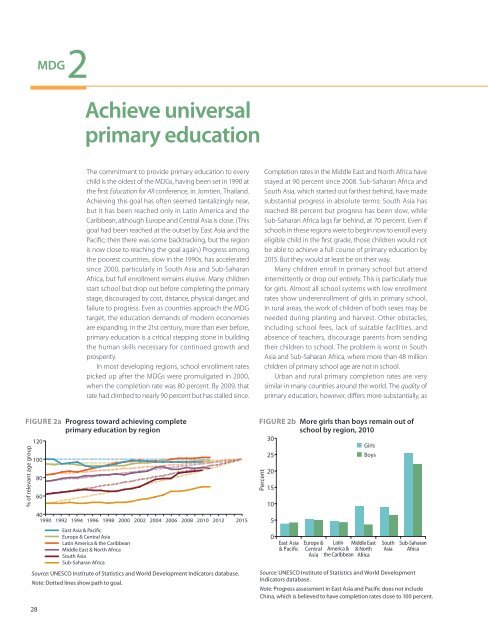rural-urban dynamics_report.pdf - Khazar University
rural-urban dynamics_report.pdf - Khazar University
rural-urban dynamics_report.pdf - Khazar University
You also want an ePaper? Increase the reach of your titles
YUMPU automatically turns print PDFs into web optimized ePapers that Google loves.
MDG<br />
2<br />
Achieve universal<br />
primary education<br />
The commitment to provide primary education to every<br />
child is the oldest of the MDGs, having been set in 1990 at<br />
the first Education for All conference, in Jomtien, Thailand.<br />
Achieving this goal has often seemed tantalizingly near,<br />
but it has been reached only in Latin America and the<br />
Caribbean, although Europe and Central Asia is close. (This<br />
goal had been reached at the outset by East Asia and the<br />
Pacific; then there was some backtracking, but the region<br />
is now close to reaching the goal again.) Progress among<br />
the poorest countries, slow in the 1990s, has accelerated<br />
since 2000, particularly in South Asia and Sub-Saharan<br />
Africa, but full enrollment remains elusive. Many children<br />
start school but drop out before completing the primary<br />
stage, discouraged by cost, distance, physical danger, and<br />
failure to progress. Even as countries approach the MDG<br />
target, the education demands of modern economies<br />
are expanding. In the 21st century, more than ever before,<br />
primary education is a critical stepping stone in building<br />
the human skills necessary for continued growth and<br />
prosperity.<br />
In most developing regions, school enrollment rates<br />
picked up after the MDGs were promulgated in 2000,<br />
when the completion rate was 80 percent. By 2009, that<br />
rate had climbed to nearly 90 percent but has stalled since.<br />
Completion rates in the Middle East and North Africa have<br />
stayed at 90 percent since 2008. Sub-Saharan Africa and<br />
South Asia, which started out farthest behind, have made<br />
substantial progress in absolute terms: South Asia has<br />
reached 88 percent but progress has been slow, while<br />
Sub-Saharan Africa lags far behind, at 70 percent. Even if<br />
schools in these regions were to begin now to enroll every<br />
eligible child in the first grade, those children would not<br />
be able to achieve a full course of primary education by<br />
2015. But they would at least be on their way.<br />
Many children enroll in primary school but attend<br />
intermittently or drop out entirely. This is particularly true<br />
for girls. Almost all school systems with low enrollment<br />
rates show underenrollment of girls in primary school.<br />
In <strong>rural</strong> areas, the work of children of both sexes may be<br />
needed during planting and harvest. Other obstacles,<br />
including school fees, lack of suitable facilities, and<br />
absence of teachers, discourage parents from sending<br />
their children to school. The problem is worst in South<br />
Asia and Sub-Saharan Africa, where more than 48 million<br />
children of primary school age are not in school.<br />
Urban and <strong>rural</strong> primary completion rates are very<br />
similar in many countries around the world. The quality of<br />
primary education, however, differs more substantially, as<br />
FIGURE 2a Progress toward achieving complete<br />
primary education by region<br />
% of relevant age group<br />
120<br />
100<br />
80<br />
60<br />
40<br />
1990 1992 1994 1996 1998 2000 2002 2004 2006 2008 2010 2012 2015<br />
East Asia & Pacific<br />
Europe & Central Asia<br />
Latin America & the Caribbean<br />
Middle East & North Africa<br />
South Asia<br />
Sub-Saharan Africa<br />
Source: UNESCO Institute of Statistics and World Development Indicators database.<br />
Note: Dotted lines show path to goal.<br />
FIGURE 2b More girls than boys remain out of<br />
school by region, 2010<br />
30<br />
Girls<br />
Percent<br />
25<br />
20<br />
15<br />
10<br />
5<br />
0<br />
East Asia<br />
& Pacific<br />
Boys<br />
Europe &<br />
Central<br />
Latin<br />
America &<br />
Middle East<br />
& North<br />
Asia the Caribbean Africa<br />
South<br />
Asia<br />
Sub-Saharan<br />
Africa<br />
Source: UNESCO Institute of Statistics and World Development<br />
Indicators database.<br />
Note: Progress assessment in East Asia and Pacific does not include<br />
China, which is believed to have completion rates close to 100 percent.<br />
28

















